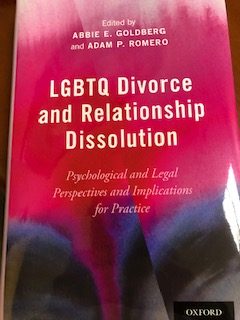LGBTQ Divorce and Relationship Dissolution – Chapter 7
 Mariette Goldenhuys and I were thrilled to be invited to write a chapter for the book LGBTQ Divorce and Relationship Dissolution. Initially, we were asked to write separate chapters on mediation and collaborative law, but then the editors decided to consolidate chapters which is now Chapter 7: Consensual Dispute Resolution with Same-Sex Couples in LGBTQ Divorce and Relationship Dissolution.
Mariette Goldenhuys and I were thrilled to be invited to write a chapter for the book LGBTQ Divorce and Relationship Dissolution. Initially, we were asked to write separate chapters on mediation and collaborative law, but then the editors decided to consolidate chapters which is now Chapter 7: Consensual Dispute Resolution with Same-Sex Couples in LGBTQ Divorce and Relationship Dissolution.
For many years, the LGBTQ community was afraid to appear in court as it was not seen as a safe place for us. At that time, it was normal practice for LGBTQ people to be arrested for all kinds of consensual type sex crimes. In some states, you could even be arrested for wearing undergarments that weren’t of your gender.
In addition, LGBTQ relationships weren’t recognized in court. There was no legal marriage, and they were called “strangers to an estate” in probate hearings, even if a couple had been living together for years. The LGBTQ community was an early adopter of consensual dispute resolution, as it provided people with an out of court method to resolve differences. Today we have the right to marry; inherit property if married or a registered domestic partner; and California courts are more respectful of the LGBTQ community.
However, there are unique issues surrounding divorce of LGBTQ couples. Couples that have been together for years and have married may not have expected to pay or receive support, and they may not realize they need to share assets as a result of their marriage. CDR allows them the room to discuss their expectations and how the law may differ from their expectations.
The skills a collaborative professional needs to work with the LGBTQ community are talked about in the chapter. If a professional is not gay, it’s necessary that they look at their own biases and microaggressions. They must be open to hearing about people’s experiences that they may not be familiar with if they’re not an LGBTQ practitioner. Some of those experiences could include that one or both of the couple may be alienated from their families of origin and may not have any family they can get support from. There may be power imbalances in the couple, based on each party’s different income or different experiences that they brought into the marriage.
In working with people whose gender expression may be more ambiguous, a collaborative professional should ask them how they would like to be referred to so they are made to feel comfortable in the collaborative process.
One of the most difficult issues that may arise in a collaborative divorce is when one party is transitioning their gender. Their spouse wants them to be referred to by their birth gender, and they want to be referred to as their preferred gender. A mental health coach can be effective in working with the parties around gender pronoun issues.
Collaborative divorce offers a safe space for LGBTQ people to discuss their relationship and how to untangle it in a private and respectful place.
Family Divorce Solutions can help guide you through your divorce.
Diane M. Goodman
17043 Ventura Blvd.
Encino, CA 91316
818-386-2889
goodmanmediation@earthlink.net
goodmanmediation.com

